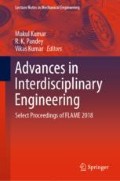Abstract
Turbulence flow of exhaust gases improves the efficiency of the catalytic converter in the exhaust system of vehicle. In literature, additional devices are used for creating the turbulence. However, they reduce the engine performance by inducing additional backpressure. In this work, various configurations of turbulence generating device are considered for optimizing the performance of the exhaust system of vehicle such as maximum conversion efficiency of the catalytic converter with minimum back pressure at engine exhaust system. In this context, various configuration device for generating turbulence is attached before the catalytic converter for measuring back pressure and analysing the exhaust of four-cylinder 1400-cc diesel engine. The flow of exhaust is visualized using commercial software Fluent for knowing effect of device configuration on the flow pattern. It has been found that the turbulence device with swirl blade configuration is more effective in improving the conversion efficiency of the catalytic converter at low back pressure as compared to other configuration of devices. Therefore, the swirl blade turbulent device is effective and efficient.
Access this chapter
Tax calculation will be finalised at checkout
Purchases are for personal use only
References
Leman AM, Rahman F, Jajuli A, Zakaria S, Feriyanto D (2017) Emission treatment towards cold start and back pressure in internal combustion engine against performance of catalytic converter: a review. In: 9th international UNIMAS STEM engineering conference (ENCON 2016), p 7
Subramani T (2012) Study of air pollution due to vehicle emission in tourism centre. Int J Eng Res Appl 2(3):1753–1763
Wang Y, Zhao T (2018) Impacts of urbanization-related factors on CO2 emissions: evidence from China’s three regions with varied urbanization levels. Atmos Pollut Res 9(1):15–26
Giovanis E (2018) The relationship between teleworking, traffic and air pollution. Atmos Pollut Res 9(1):1–14
Zalakeviciute R, Rybarczyk Y, López-Villada J, Diaz Suarez MV (2018) Quantifying decade-long effects of fuel and traffic regulations on urban ambient PM2.5 pollution in a mid-size south American city. Atmos Pollut Res 9(1):66–75
Taylor KC (1987) Automobile catalytic converters. Stud Surf Sci Catal 30:97–116
Mohiuddin AKM, Rahman A (2012) Investigation using simulations for the development of low cost catalytic converter from non-precious metals. Adv Mater Res 445:899–904
Farrauto RJ, Heck RM (1999) Catalytic converters: state of the art and perspectives. Catal Today 51(3–4):351–360
Korin E, Reshef R, Tshernichovesky D, Sher E (1999) Reducing cold-start emission from internal combustion engines by means of a catalytic converter embedded in a phase-change material. Proc Inst Mech Eng Part D J Automob Eng 213(6):575–583
Amirnordin SH, Seri SM, Salim WSW, Rahman HA, Hasnan K (2011) Pressure drop analysis of square and hexagonal cells and its effects on the performance of catalytic converters. Int J Environ Sci Dev 2(3)239–247
Brück R, Diewald R, Hirth P, Kaiser F (1995) Design criteria for metallic substrates for catalytic converters. SAE Eng Soc Adv Mobil L Sea Air Sp, p 12
Santos H, Costa M (2014) Influence of the three way catalytic converter substrate cell density on the mass transfer and reaction resistances. Chem Eng Sci 107:181–191
Santos H, Costa M (2008) Analysis of the mass transfer controlled regime in automotive catalytic converters. Int J Heat Mass Transf 51(1–2):41–51
Joshi SY, Harold MP, Balakotaiah V (2010) Overall mass transfer coefficients and controlling regimes in catalytic monoliths. Chem Eng Sci 65(5):1729–1747
Tsinoglou DN, Koltsakis GC, Missirlis DK, Yakinthos KJ (2004) Transient modelling of flow distribution in automotive catalytic converters. Appl Math Model 28(9):775–794
Arrighetti C, Cordiner S, Mulone V (2007) Heat and mass transfer evaluation in the channels of an automotive catalytic converter by detailed fluid-dynamic and chemical simulation. J Heat Transfer 129(4):536–547
Hirata K, Oda R, Tanaka S, Tanigawa H, Funaki J (2008) Pressure-loss reduction and velocity-profile improvement in a catalytic converter by a flow deflector. Proc Inst Mech Eng Part D J Automob Eng 222(3):455–467
Soumelldis MI, Stobart RK, Jackson RA (2007) A chemically informed, control-oriented model of a three-way catalytic converter. Proc Inst Mech Eng Part D J Automob Eng 221(9):1169–1182
Eghlimi A, Kouzoubov A, Fletcher CAJ (1997) A new RNG-based two-equation model for predicting turbulent gas-particle flows. In: Proceedings of the first international conference on CFD in mineral & metal processing and power generation industries, CSIRO, pp 279–284
ANSYS FLUENT theory guide, “Turbulence”, pp 46–137
Author information
Authors and Affiliations
Corresponding author
Editor information
Editors and Affiliations
Rights and permissions
Copyright information
© 2019 Springer Nature Singapore Pte Ltd.
About this paper
Cite this paper
Agrawal, T., Banerjee, V.K., Sikarwar, B.S., Bhandwal, M. (2019). Optimizing the Performance of Catalytic Convertor Using Turbulence Devices in the Exhaust System. In: Kumar, M., Pandey, R., Kumar, V. (eds) Advances in Interdisciplinary Engineering . Lecture Notes in Mechanical Engineering. Springer, Singapore. https://doi.org/10.1007/978-981-13-6577-5_31
Download citation
DOI: https://doi.org/10.1007/978-981-13-6577-5_31
Published:
Publisher Name: Springer, Singapore
Print ISBN: 978-981-13-6576-8
Online ISBN: 978-981-13-6577-5
eBook Packages: EngineeringEngineering (R0)

